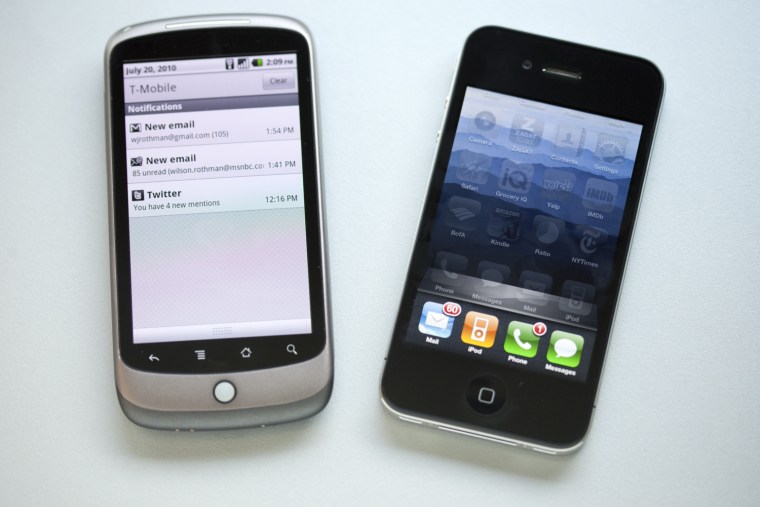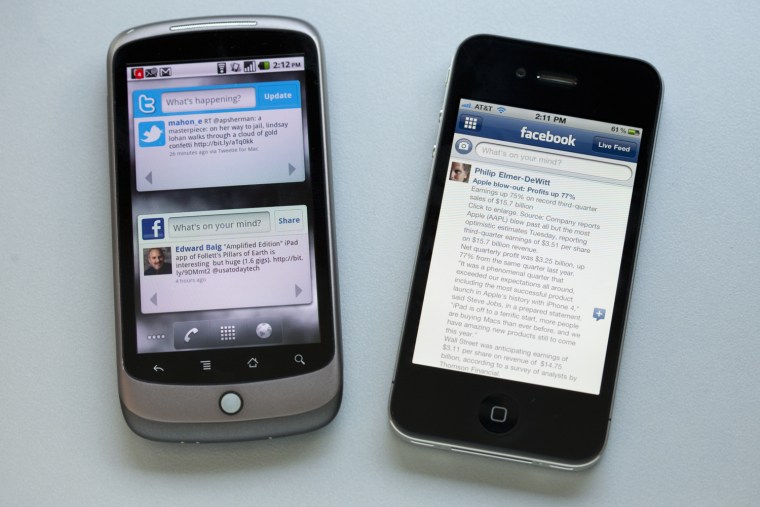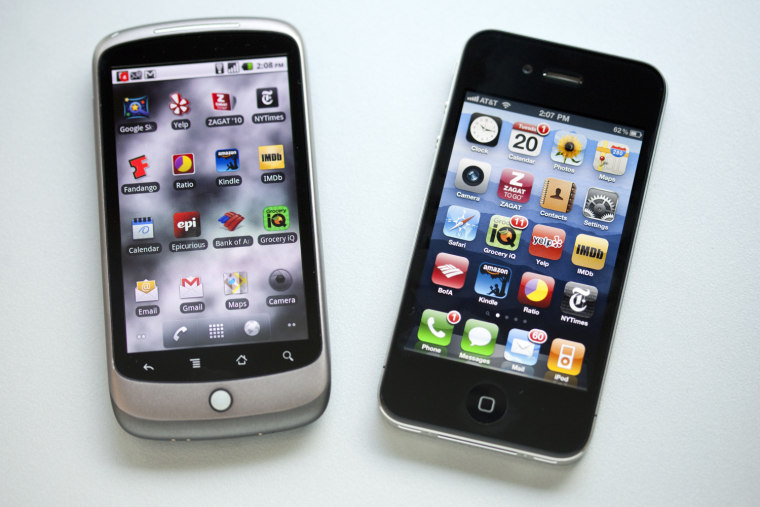I have, of late, fallen in love with Android, and my hunch is, you will too.
I've carried an iPhone in my hip pocket for what seems like aeons, content in the belief that no other device could navigate to a little park in a town 100 miles away, sync a grocery list with my wife's phone, tell me where to get decent sushi in Park City, remind me of the bones-to-water ratio of veal stock, and stream music or New York Times headlines to me on demand — both at the same time, even.
I was wrong. The latest Android phones, running the latest Android software, can do all of this and more — most of what an iPhone can do, in fact. In some cases, the Android phone does it better.
If I sound at all surprised, it's because Google's little mobile OS did not explode out of R&D with any competitive edge. It was clumsy, both aesthetically and functionally, did not have a huge line of developers waiting to write apps, and was available first on an underpowered phone sold only by T-Mobile, the fourth-place U.S. carrier. Inauspicious beginnings, you might say.
Last fall, Android got its biggest forward push when Verizon Wireless, the country's biggest carrier, rolled out the Motorola Droid, first in a line of Droid-branded phones from Motorola and HTC. It was made of sturdy metal, with a fast chip and a Lucasfilm-licensed name. Most important was its software: It ran the vastly improved 2.0 version of Android, and came with Google's own voice-guided turn-by-turn GPS navigator. People who had disregarded earlier pretenders to the iPhone throne got behind this one. Not just customers, app developers.
Now, Android is available on every carrier, in multiple shapes and sizes. Many are at least as powerful as the Moto Droid. Google itself released the Nexus One, in part to spur Android's hardware partners to keep their specs cranked and their screens crisp. (Though I tested four Android phones for this article, the Nexus One is the demo I used for photos, because it runs only the Android OS — no carrier or manufacturer interface extras — and it has the latest version, Android 2.2 "Froyo." Sadly, the Nexus One is being discontinued in the U.S.)
Now, all the carriers are up to speed. In the $130 to $200 range, you can pick up Verizon's Droid Incredible by HTC and Droid X by Motorola, Sprint's HTC Evo, T-Mobile's MyTouch 3G Slide, AT&T's Samsung Captivate and HTC Aria. And soon you'll see Samsung's Galaxy S phone, coming out on all of the big four carriers (albeit under confusingly different model names).
This surge has given Android a jump in market share, from 9 percent to 13 percent, according to ComScore, with more momentum last quarter than any other platform. A huge part of that momentum comes from developers, who have to date contributed more than 70,000 apps to the Android Market. That may pale in comparison to the iPhone's 230,000 apps, but it's hard at first to find any apps that aren't available for Android — or promised as coming soon.
Look, when the iPhone 4 isn't dropping calls — and to be honest, it doesn't really drop any more calls than its predecessors — it has beauty and grace that you won't find in the above handsets. But let's look at what you can find, plentifully, in the current crop of Android phones:
Apps and widgets
On the iPhone, there are apps. On Android, there are apps and widgets. A widget is a tiny slice of an app that shows up on the phone's home screen. This lets you experience a bit of the app without actually launching it. Take social networking, for example: To get a Facebook update on an iPhone, you either dive into the Facebook app, or set it to give you push notifications, pop-up messages that tell you that someone has written on your wall, or replied to your direct message. On Android, you can browse the most recent posts in your feed without leaving the home screen, diving into the app only if you want to go deeper.
Widgets, like apps, are made by developers, and you get the option to add them to your home screen once you download the app. For instance, before you download the Epicurious cooking app, you don't see the widget. But once you download the free app, the widget appears in the widget menu.

Multitasking
The iPhone OS was famously bestowed with "multitasking" powers this year, after owners clamored for it for years. And what does it mean, exactly? For phone users, it mostly means being able to play music, or download files, or get GPS instructions, while running a different app. Android has natively supported multitasking among apps since its start, though it was long ridiculed for supporting something that everyone knew could contribute to terrible battery life. Battery life is still an issue — in my experience no Android phone can beat an iPhone on battery life — but newer Android phones do last longer on a charge. Besides, the latest version of the OS is smarter about managing apps to preserve memory (and battery life).
What's important to know about multitasking is that Android — having done it longer — does it better, in terms of interface. There's a pull-down "drawer" at the top of the screen that can be accessed no matter what you're doing. It serves to alert you when you need to be alerted, but it gives you lots of other information — how many messages you have, how far along a file download has come — information you just can't get from Apple's multitasking. That's not to say Apple's isn't workable, and a huge improvement over what came before. It's just not as nice.
Web browsing
Since both iPhones and Android phones have terrific Web browsers, the biggest differentiator between them is Adobe's Flash. Apple CEO Steve Jobs has ranted and raved against this video and graphics platform used all around the World Wide Web. Flash support wasn't something that any phones came standard with, mostly because, just like Jobs said, it is very taxing on a phone's processor. But Android 2.2 gives phones the ability to play Flash video inside the browser. And playback on the phone I tested, the Nexus One with 1GHz processor, worked fine.
Since most of YouTube and much of the Web is now distributing low-resolution video in a phone-friendly video codec called H.264, you really don't miss too much. But Jobs has crusaded against Flash on the iPad as well, and that's where it gets dicier. Let's put it this way: Apple should damn well beware an Android tablet that's built to compete with the iPad.
Though both Apple and Google also have their own computer browsers (Safari and Chrome, respectively), only Google is using it to teleport Web pages and files directly to the phone. With the latest Android OS release and a small app, Android users can zap anything from their Chrome browser to their phones in a blink. There are iPhone apps that can do similar feats, but none have this kind of native simplicity.

Music and movie syncing
Apple is one of the world's biggest music retailers, and iTunes is one of the most downloaded computer apps in history. So it's no surprise that the iPhone — which, along with its iSiblings, enjoys an exclusive ability to sync to iTunes — is a media machine first and foremost. Watching movies, listening to music, this is what people do on an iPhone. (In fact, iPod sales have gone down because nobody with an iPhone really needs one.)
By contrast, Android has been ridiculed for its lack of media support. The phones play all kinds of files — more kinds of files than iPhones can. But the phone's native video player is hidden inside the Gallery app, and there's no official software for syncing all of your music and movie files from desktop to phone.
Google envisioned the Android platform as one that isn't tied to the desktop, but I personally own 15,000 songs, and I'm not sure how else to port them all over. Movies take up 1GB a piece on average — shifting those around wirelessly is downright dumb. You can plug in an Android phone and drag files to it, but that is an intimidating process for many people (including both my parents, both my in-laws, and a fair number of my siblings and friends).
Enter DoubleTwist. It looks like iTunes, runs on Windows and Mac machines, and syncs with most or all Android phones, just like iTunes syncs with iPhones. It slurps all of your music and video files from iTunes, and even pulls up your iTunes playlists. (If you're like me, this is of utmost importance.) DoubleTwist has Amazon's music store and Android's app market built in, and it even notifies you when you have music files that aren't compatible with it, because of Apple copy protection. It's not perfect, but it's a huge step forward for a platform that needs a better media juggler. Best of all, there's a DoubleTwist app for the phone itself, so you can easily find videos, albums and playlists. And did I mention it's free?
Still catching up
There are some important reasons why Android isn't completely neck and neck with iPhone. There may be plenty of apps, but some developers fear writing for a platform with so many phone models, with so many different screen sizes and processor speeds. Notably late to the Android party is the video game industry, which has seized on iPhone as a post-Nintendo darling. Screen and processor differences would affect your first-person shooting far more than they'd affect your Facebook statuses, but still, word is that most major mobile-game developers are planning some kind of Android rollout this year.
Another thing that can be confusing to developers and shoppers alike is that Motorola, Samsung and HTC tend to put their own software layers on top of Android, the way they did with Windows Mobile before. With HTC, this is fairly innocuous and can be pleasant — the Sense interface lets you view multiple screens at once, and jump around to find the app or widget you need. It's not necessary, but it's not offensive. Others, such as Motorola's Blur interface and Samsung's TouchWiz interface are not as beloved in the nerd community. The truth is, Android is at its best when its interface is clean.
Because of the interface and under-the-hood differences, Android hardware doesn't all get updated at the same time. This is a particular concern now, since the Froyo Android 2.2 update makes phones run faster and more efficiently, and provides some neat tricks, too. The Google Nexus One phone is already updated with 2.2, but it won't go out to other phones for a few weeks, if not a few months. iPhones, by contrast, are all eligible for software updates at the same time.

Buying advice
It's important that you know about those things, so that you don't buy the wrong phone. For starters, you need to buy a phone with at least 1GHz processor and a minimum screen resolution of 480x800 pixels. That will keep you from walking out of the store with an obsolete phone in your hand. When buying, you should ask the sales person if the phone is running the latest version of Android, and if not, when the carrier predicts that the version will arrive.
As bumpy as that might seem, bear in mind that Apple currently sells two iPhones with different screen resolutions and processor speeds, and recently provided an update whose major benefit, multitasking, only applied to phones sold in the last year or so.
I'm not about to ditch my iPhone — Hey, I'm in a 2-year contract! — but if you're in the market for a smart phone now or anytime through the holidays, take a look at Android. It's finally out of the geek garage and ready for a spin.
Catch up with Wilson on Twitter at @wjrothman, where he'll be happy to chat about your smart phone or your dumb phone. Don't worry, he won't judge. (Actually, he probably will.)
